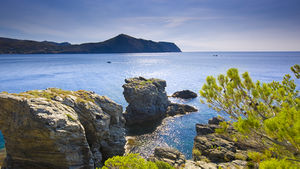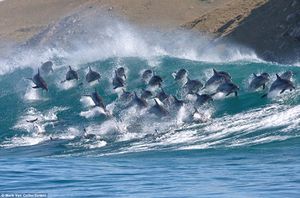Bay of Crowns

The Bay of Crowns is a large body of water separating the capital city of Bellissimomare from the mouth Sabre River in the nation of Sayaffallah. It is an unseasonably warm body of water due to large openings in the fault lines under the bay that allow thermally heated water to rise up to the surface. The warm temperatures of this water make it a tourist destination in the winter when steam can be seen rising off the bay and a destination in the summer for those who wish to see the marine mammals that frolic openly in the bay. The size of the bay of crowns encompasses a total of 400 miles across at its widest point and a total depth can be reached of 985 feet at its deepest point leading many within Sayaffallah to believe it is the deepest in known existence within the country.
Etymology and history
The original name of the bay is Shankar Dalastarian which means "Lake of Heat" in the original native dialects of the tribes that lived along the banks before it was settled later on in its history. The name Bay of Crowns came later on in its history as the bay of waters became the sight of several coronations and later on battles for throne as navies attempted to cross it and gain access to the capital city of Bellissimomare. In the 1600s when the Islamic invasion occurred the Bay of Crowns was renamed to the Bay of Islam but the name never caught on and the people continued to refer to it by the name Bay of Crowns and the name stuck for generations and to this day is still referred to by this name.
Flora and fauna
Marine wildlife
Due to its unseasonably warm waters the Bay of Crowns has become home to a significant variety of marine wildlife that travel through the wide river to get to the Bay of Crowns where the warm waters create the environment necessary for the birthing of calves and the mating cycles to achieve optimal results. Researchers have also marveled at how the bay has transformed itself into an active salt water reef environment with vast reefs stretching across isolated portions of the Bay of Crowns.
The Bay of Crowns also hosts many migratory species, such as the humpback whale, California gray whale, killer whale, manta ray, Humboldt squid and leatherback sea turtle, and the world's largest animal, the blue whale. The unusual resident populations of fin whales and sperm whales do not migrate annually. The area near the delta of the Colorado river has a small remnant population of the totoaba fish. This region has historically been a magnet for world-class sport fishing activities, with a rich history of sporting world records established within the bay and mouth of the river. Among the tropical coral reefs are a wide variety of more than 1,500 fish species including the clownfish, red bass, red-throat emperor, and several species of snapper and coral trout. Forty-nine species mass spawn, while eighty-four other species spawn elsewhere in their range. Seventeen species of sea snake live in the bay enjoying its warm waters up to 120 feet deep (36 meters) and are more common in the southern than in the northern section of the bay.
Six species of sea turtles come to the reefs in the Bay of Crowns to breed: the green sea turtle, leatherback sea turtle, hawksbill turtle, loggerhead sea turtle, flatback turtle, and the Olive Ridley. The green sea turtles in the Bay of Crowns have two genetically distinct populations, one in the northern part of the reef and the other in the southern part. Fifteen species of seagrass in beds attract the dugongs and turtles, and provide fish habitat. Saltwater crocodiles live in mangrove and salt marshes on the coast near the reef. Nesting of the crocodile population typically has been seen on the eastern side where a large wildlife preserve exists close to the mouth of the river that flows out of the bay. Around 325 species of shark, stingray, skates or chimaera live on the reef. Close to 35,000 species of mollusc have been recorded on the reef, including the giant clam and various nudibranchs and cone snails. Forty-nine species of pipefish and nine species of seahorse have been recorded as well.
Flora
The Bay of Crowns is a salt water bay with a high concentration of natural mineral rich springs and faults running throughout the seafloor of the bay. Because of the salt water content the types of plants growing both within the Bay of Crowns and around its periphery vary but are all common saltwater rich plants that thrive off the climate and the landscape of the Bay of Crowns. The Bay of Crowns features typical species of wet habitats which are several endemic Cyperus sedges, ferns, pandans (Pandanus), and the traveller's tree (Ravenala madagascariensis). Two species of water lilies, Nymphaea lotus and N. nouchali, are found in the west and east, respectively. Lagoons are mainly found on the western shores of the bay extending inland for several dozen miles.
Much of the coastline is populated by large sand dunes extending to the shore with the exception of the areas closest to the lagoons and mangrove swamps on the eastern and western ends. The sand dunes are constantly shifting as a result of wind direction and their changing pace results in problems with containment as sand rapidly expands over the areas in which it is blown. During the summer months there are frequent sand storms that blow into the capital of Bellissimomare creating dangerous and hazardous driving conditions for those within the city itself during the midst of the sand storms. In addition to this there are large palm trees that dot the coastline many of them being date palms which are harvested during their peak season and sold in the marketplaces on the outskirts of the cities along the coastal stretches.
Geological activity
Hydrothermic vents
The Bay of Crowns features 36 fault lines all with hydrothermic vents that allow for sulphuric gases to rise up through the water. The highest salinity of the water prevents the sulfuric content from metabolizing into a direct threat to the marine and plant based life within the Bay of Crowns and thus instead is diluted and forms a warm texture within the water itself. The mineral content has been found helpful in the healing and treatment of a variety of diseases, disorders and conditions both on a physiological and neurological level. The mineral dispersion is a result of the release of sulfuric compounds from the vents in the thermal and geothermal layers under the seafloor of the Bay of Crowns. This dispersion of minerals is believed to be a partial reason for the diversity of marine life and why so much marine life migrates in and out of the Bay of Crowns on a frequent basis.
Mineral dispersions within the hydrothermic vents also creates a dispersionary pattern that leads to the multiplying effect of sea mammal reproductive activities on a wider scale. The hydrothermic vents are approximately 6 feet in diameter and scattered in a layered pattern, because of the heat of the sulfuric exchange sea plants typically are nestled away from the opening of the vents although there have been peculiar patterns of some sea plants going directly over the vent as a way of absorbing a maximum of nutrients emitted from the sulfuric exchange process.
Climate impact
The hydrothermic vents along the 36 different fault lines creates a warm than usual water temperature scale that is at its most active during the winter months as temperatures in the surrounding terrain plummet into cold extremes. These cold temperatures means that as the vent interacts with the freezing cold on the mainland it results in the vents heating up and expelling greater quantities of sulfuric exchange thus increasing the temperature within the water itself. The water temperature increase begins gradually and reaches its peak in the mid part of January when most of the marine wildlife has already migrated out of the Bay of Crowns and into the southern stretches for the remainder of the winter.
Scientists have established probes within the vent to monitor temperature fluctuations and have found that as magma levels rise and fall so does the temperature in an almost perfect sync with the magma and seismic activity. Magma dispersion is at a constant equilibrium state within the vents and there are noticeable tubules within the ground itself allowing for an even flow of magma. Researchers believe that in the center of the lake there is potential for a seismic eruption of a volcano that has been building for close to 1500 years and that if an eruption occurs it is likely to cause significant disruption to the vents and potentially lead to either a significant drop or a moderate warming of the water temperature itself.
